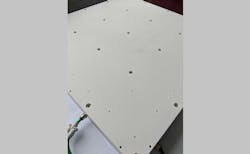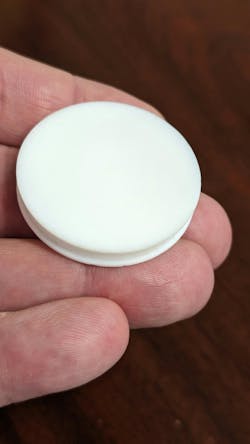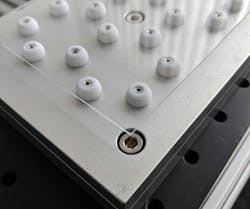What role does PTFE play in laser processing?
In the realm of precision manufacturing, the need for highly efficient and repeatable processes is paramount. A critical area where precision plays a vital role is laser structuring of glass and the ablation of silicon substrates.
These processes demand meticulous alignment and stability to achieve desired outcomes. Polytetrafluoroethylene (PTFE), particularly the glass-filled PTFE G400 variant, has emerged as an indispensable material to support substrates during laser processing.
Understanding PTFE and its properties
PTFE, commonly known as Teflon, is a fluoropolymer known for its exceptional chemical resistance, low friction coefficient, and high temperature stability. These properties make PTFE an ideal choice for various industrial applications (see Fig. 1). When PTFE is reinforced with fillers such as glass fibers, bronze, carbon fiber, or fused silica, it gains additional mechanical strength and dimensional stability.
Attributes of glass-filled PTFE
Glass-filled PTFE G400 is a specific variant that incorporates glass fibers into the PTFE matrix to enhance its strength and stability. This composite material is particularly suited to support glass and silicon substrates during laser processing due to four key attributes:
Mechanical strength and stability. The addition of glass fibers significantly enhances its mechanical strength. This reinforcement ensures that the material can support the substrates without deformation and maintain the precise alignment required for laser processing.
High temperature resistance. Laser processing—especially nanosecond and picosecond laser techniques—generates substantial heat when focused. The material’s high-temperature resistance ensures it remains stable and does not degrade under general average power and peak power conditions of ultrashort-pulse laser processing.
Chemical inertness. PTFE is inherently chemically inert, which means it does not react with the substrates or any residues produced during the laser process. This property is crucial to maintain the integrity and cleanliness of substrates.
Low friction coefficient. The low friction coefficient of the material allows for smooth handling and positioning of substrates, which minimizes the risk of damage during the setup and processing stages.
Enhanced visibility and alignment
One of the standout features of PTFE is its pseudo-bright white appearance. It provides a stark contrast between the substrate and the background, which significantly enhances visibility during the machine vision inspection and alignment phases. Accurate alignment of the substrate is crucial in laser processing to ensure the laser beam interacts with the material at the correct location and angle.
Its high contrast provided allows operators to achieve precise manual as well as automatic machine vision alignment quickly and efficiently, which reduces setup time and increases throughput. Figure 2 shows a corner puck to enhance machine vision contrast to find and align with substrate corners.
Stability during nanosecond and picosecond laser processing
Nanosecond and picosecond lasers deliver high-energy pulses in extremely short durations, which can precisely modify the surface of glass substrates or ablate silicon with minimal thermal damage to the surrounding material. But the success of these processes heavily relies on the stability and support provided to the substrates. When incorporated into a fixture or vacuum chuck, PTFE G400's mechanical strength and thermal resistance ensure substrates remain securely in place. This exact positioning is required for the laser beam to achieve the desired Bessel beam structuring or milling via ablation.
Versatility of fillers in PTFE
PTFE G400 can be tailored with various fillers to meet specific application requirements:
Carbon fiber. This provides excellent mechanical strength and electrical conductivity ideal for applications that require robust support and conductivity.
Different types of glass (including fused silica). Enhances dimensional stability and reduces thermal expansion. Fused silica offers exceptional thermal shock resistance and is suited for high-temperature applications.
The availability of these different fillers allows PTFE G400 to be customized for a wide range of laser processing environments to ensure optimal performance and durability (see Fig. 3).
Efficient and repeatable laser processing
The combination of enhanced visibility, precise alignment, and stable support provided by PTFE G400 is critical for efficient and repeatable laser processing of glass and silicon substrates (see Fig. 4). Repeatability is a key factor for industrial manufacturing, where consistent quality and performance are required across large production runs. PTFE G400 helps achieve this by ensuring that each substrate is processed under identical conditions, with minimal variation in positioning or alignment. This consistency translates to higher yields and reduced waste, and ultimately leads to cost savings and improved productivity.
The use of glass-filled PTFE G400 has transformed laser processing of glass and silicon substrates, for these reasons:
- Its unique properties, including mechanical strength, high temperature resistance, chemical inertness, and low friction coefficient, make it an ideal material to support substrates during nanosecond and picosecond laser structuring and ablation.
- Its bright-white appearance enhances visibility and aids precise alignment of substrates, which is critical for efficient and repeatable laser processing.
- The availability of various fillers, such as bronze, carbon fiber, and different types of glass, allows for customization to meet specific application needs.
As laser processing techniques continue to advance, the role of materials will remain indispensable to ensure the highest standards of precision, accuracy, quality, and repeatability in manufacturing.
About the Author
Todd E. Lizotte
Todd E. Lizotte is the president and CEO of BOLD Laser Automation (Bedford, NH).



